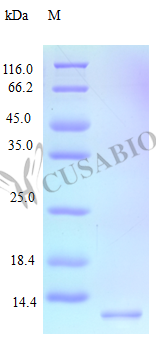The recombinant human CCL15 protein is expressed in E. coli and covers the full length of the mature 22-113aa sequence. This tag-free protein is provided as a lyophilized powder, allowing for easy reconstitution with sterile water or buffer. With a purity of >97% as determined by SDS-PAGE and HPLC, our recombinant CCL15 also maintains a low endotoxin level of less than 1.0 EU/µg, as measured by the LAL method. The protein retains full biological activity, as demonstrated by its effectiveness in a chemotaxis bioassay using human T-lymphocytes, with an activity concentration range of 1.0-10 ng/ml.
C-C motif chemokine 15 (CCL15) is a member of the CC chemokine family and plays a crucial role in regulating immune cell trafficking and function. As such, understanding the functions and mechanisms of CCL15 is vital in uncovering the roles it plays in the immune system and the development of potential therapeutic interventions for immune-related diseases.




